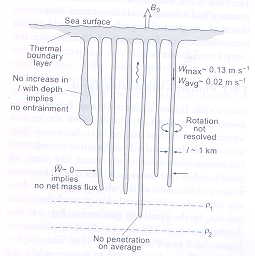|
Sea Ice is a very important factor in deep ocean circulation and deep ocean circulation is thought to be an important factor in the long term climate of the earth. At high latitudes salinity is the main determinate of sea water density. As sea ice is growing, salt is rejected from the ice. The salt then mixes with the sea water underneath the ice layer. Because of this ice-rejected salt, the water directly beneath the ice is very saline and thus has a high density. In addition to having high salinity, the water is cold. In the ocean, cold, dense water is convected downwards to great depths (see picture below). This convection is what in part drives the deep ocean circulation. If the deep ocean circulation were to stop, for instance, because there was no cold, dense water from sea ice, areas in the North Atlantic would have drastically different climates. The climate of much of the North Atlantic is warmed because deep ocean
convection, as described previously, occurs there. The cold waters in the
North Atlantic sink to the bottom and are replenished with warmer waters
from the North Atlantic Current. These warm waters mediate the climate
of the North Atlantic and without them the temperatures would be much colder
(See above Figure).
|
|
|
|
Shipping Concerns |
| Sea Ice presents hazards to maritime shipping. So being able to understand and possibly predict sea-ice growth and decay is important to the maritime shipping industry. One important tool for monitoring sea-ice for shipping is remote sensing (synthetic aperture radar (SAR) and other methods). Wave-sea ice interactions are important to remote sensing applications because sea ice damps short ocean waves. Short ocean waves are the waves that scatter radar signals. So in SAR images, sea ice appears dark. |

Image Source: http://fram.nrsc.no/CEO_Training/Training%20and%20Education/html/Word_html/Tr_Man_1.1.htm Most ships cannot do what the above vessel is doing so wave-ice interactions are important for maritime shipping. |
|
|
| Last Modified: 12/12/2001 |

